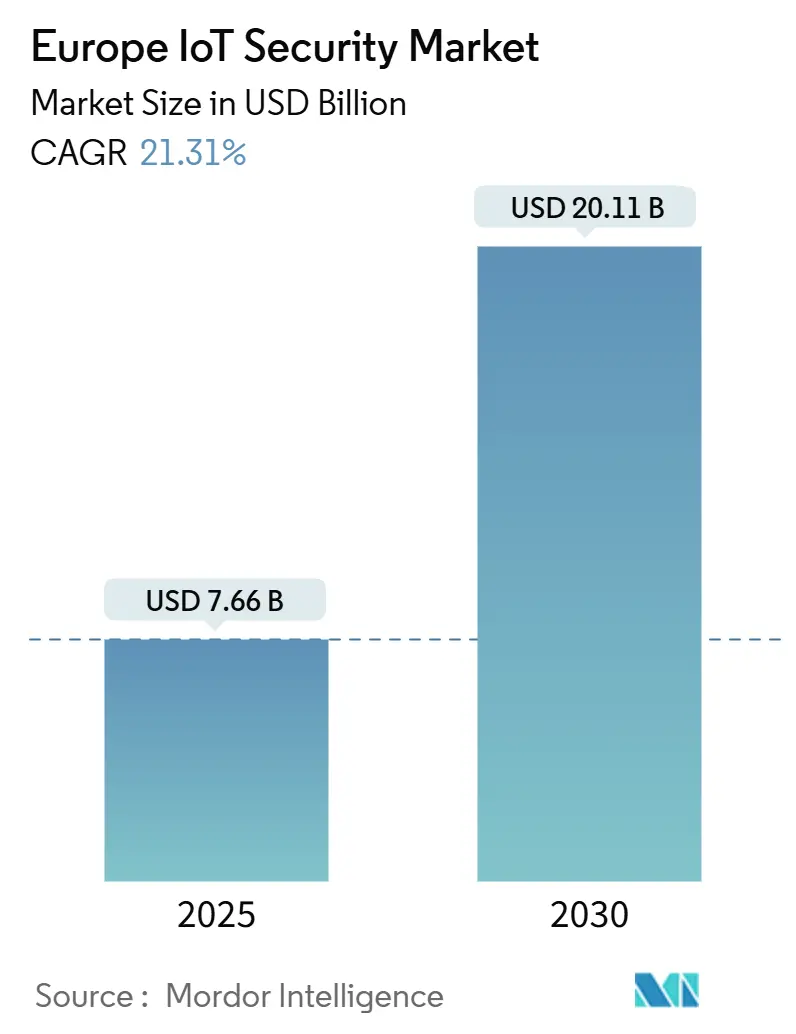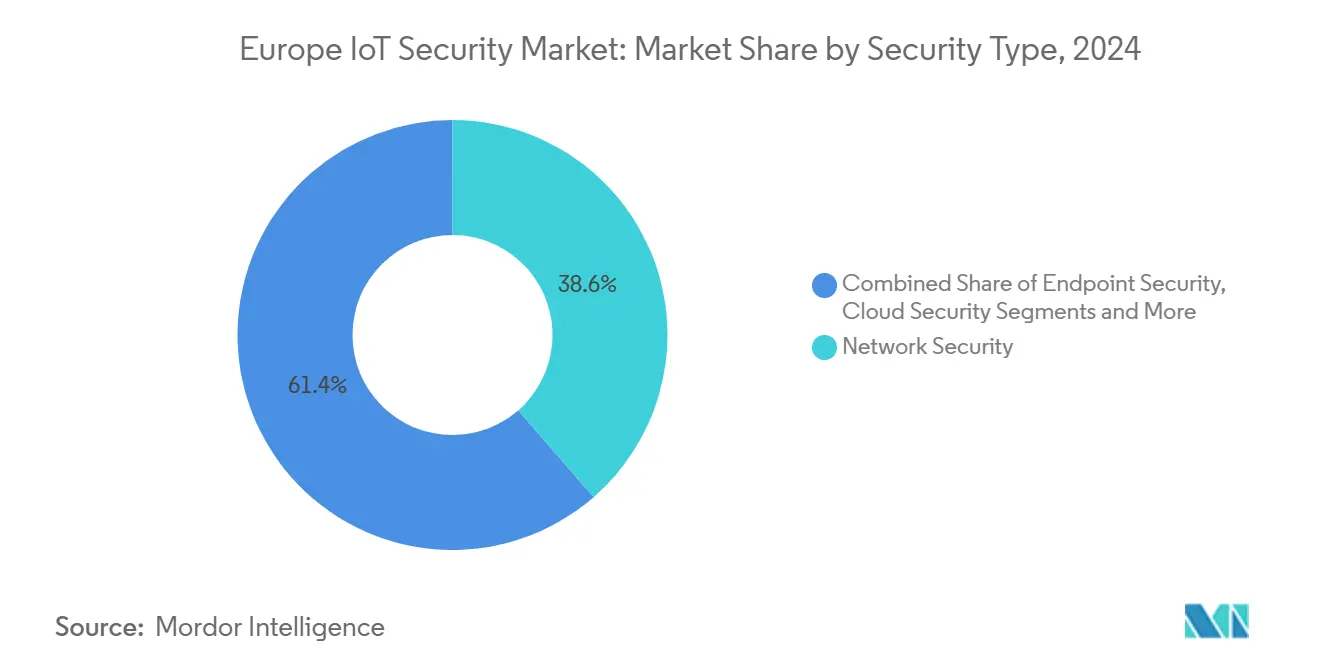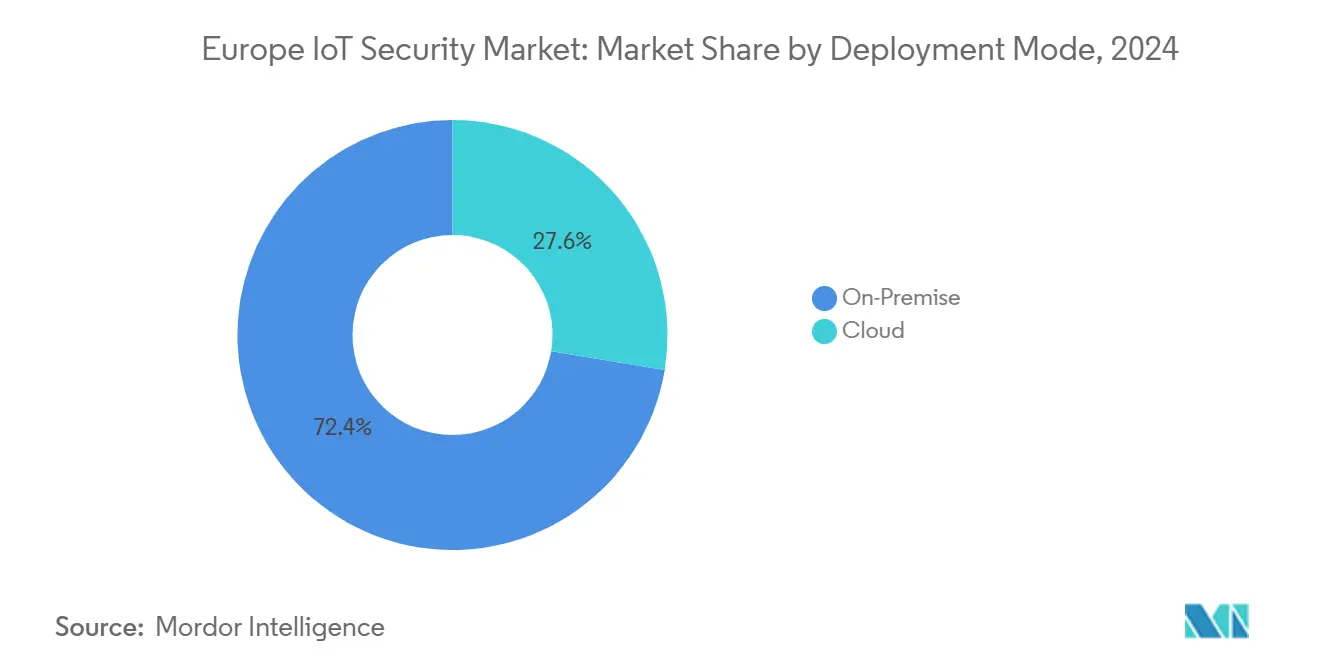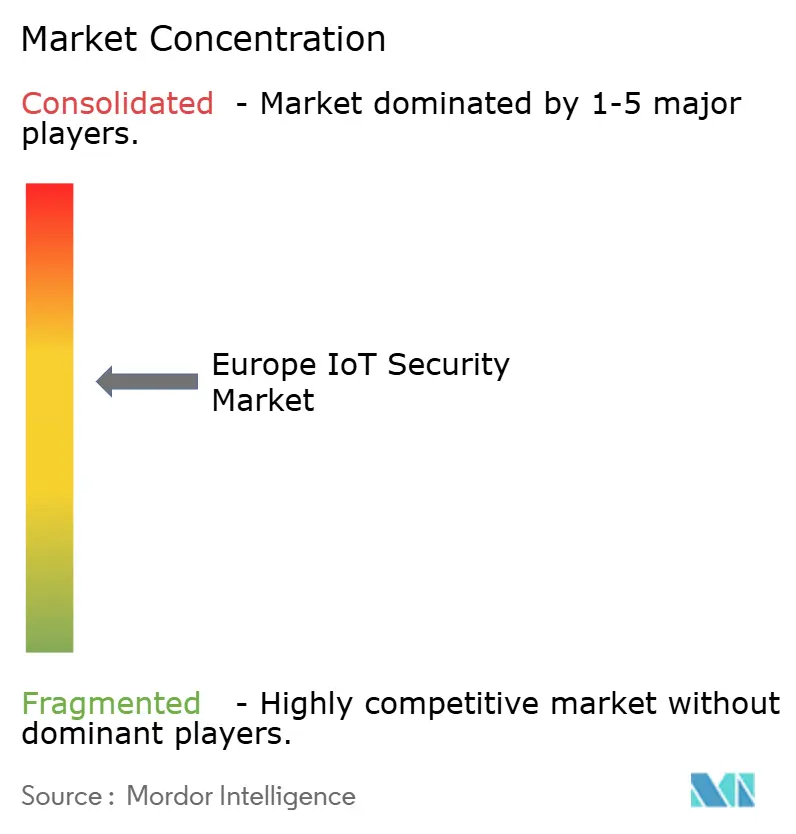
Europe IoT Security Market Analysis by Mordor Intelligence
The Europe IoT Security market size is valued at USD 7.66 billion in 2025 and is forecast to reach USD 20.11 billion by 2030, registering a 21.3% CAGR. Rising cyber-attacks on connected devices, stringent regulatory mandates and fast adoption of Industrie 4.0 solutions in manufacturing combine to accelerate spending on specialised security platforms. Demand concentrates on network-centric defences that safeguard operational technology, while quantum-safe cryptography investments signal long-term resilience priorities. Vendors offering hybrid cloud-edge security analytics gain traction as enterprises balance data-sovereignty rules with the need for scalable threat intelligence. Intensifying competition from niche start-ups and semiconductor players is prompting incumbents to acquire specialised capabilities, especially around AI-driven detection and secure-element design.
Key Report Takeaways
- By security type, Network Security led with 38.6% of the Europe IoT Security market share in 2024, while Cloud Security is projected to grow at 21.5% CAGR through 2030.
- By solution, Software accounted for 66.5% of the Europe IoT Security market size in 2024; Services record the highest forecast CAGR at 22.8% to 2030.
- By deployment mode, On-Premise installations held 72.4% revenue share in 2024, whereas Cloud deployment is advancing at 23.0% CAGR.
- By end-user industry, Manufacturing & Industrial commanded 36.1% share of the Europe IoT Security market size in 2024; Healthcare & Life Sciences is growing the fastest at 21.7% CAGR.
- By country, Germany captured 41.8% revenue share in 2024; the United Kingdom shows the strongest outlook with 22.4% CAGR to 2030.
Europe IoT Security Market Trends and Insights
Drivers Impact Analysis
| Driver | (~) % Impact on CAGR Forecast | Geographic Relevance | Impact Timeline |
|---|---|---|---|
| Proliferation of IoT endpoints enlarging attack surface | +4.2% | Global | Medium term (2-4 years) |
| EU-wide data-protection mandates accelerating security spend | +5.8% | EU-wide | Short term (≤ 2 years) |
| Rapid industrial-IoT adoption in smart factories | +3.9% | Germany, France, Italy | Medium term (2-4 years) |
| Sophisticated cyber-attacks on critical infrastructure | +4.5% | Global, with focus on Western Europe | Short term (≤ 2 years) |
| Post-quantum-ready cryptography initiatives | +2.1% | EU-wide, with early adoption in France, Germany | Long term (≥ 4 years) |
| Horizon Europe and national grants subsidising SME security upgrades | +1.8% | EU-wide, particularly Central and Eastern Europe | Medium term (2-4 years) |
| Source: Mordor Intelligence | |||
Proliferation of IoT Endpoints Enlarging Attack Surface
European enterprises added millions of sensors, gateways and robotics units during 2024, driving a 107% spike in IoT-focused attacks. Manufacturing recorded more than 500 ransomware incidents that disrupted discrete production lines and forced costly downtime. Legacy brownfield machinery integrating with IP-based networks dissolves traditional perimeters, compelling CISOs to deploy scalable zero-trust agents and secured device-management overlays. Demand for endpoint protection platforms that remotely enforce firmware integrity and detect anomalous behaviour therefore rises across the Europe IoT Security market. Vendors that can monitor heterogeneous devices without impacting operational throughput gain competitive advantage among Industrie 4.0 adopters.
EU-wide Data-Protection Mandates Accelerating Security Spend
The NIS2 Directive, effective from October 2024, extended breach-reporting and risk-management obligations to about 350,000 European organisations[1]ENISA, “NIS2 Directive Explained,” enisa.europa.eu. Parallel enactment of the Cyber Resilience Act compels manufacturers to embed security-by-design and maintain software bills of materials, with fines reaching EUR 15 million. Healthcare and telecom operators in France already face active audits by ANSSI following several multi-million-record breaches during 2024. Compliance urgency is translating into immediate budget reallocations toward managed detection, vulnerability management and supply-chain assessment solutions, fuelling short-term growth across the Europe IoT Security market.
Rapid Industrial-IoT Adoption in Smart Factories
Germany’s Industrie 4.0 roadmap sustains annual digitalisation investments approaching EUR 40 billion, prompting factories to converge IT and OT environments. UN Regulation 155 on automotive cybersecurity further mandates secure software-update capabilities for vehicle manufacturers, magnifying demand for specialised OT firewalls, protocol-aware intrusion detection and digital-twin testing platforms. The EUR 33 million DAIS project illustrates the strategic push toward AI-enabled edge computing that processes industrial data locally, thereby reducing cloud exposure yet requiring robust on-premise cryptography.
Sophisticated Cyber-Attacks on Critical Infrastructure
Ransomware campaigns against European utilities grew 19% in 2023, with 80% of incidents inducing physical consequences from halted production to regional power outages. Investigations in Spain and Portugal into GPS spoofing and suspected sabotage underline the geopolitical stakes of IoT vulnerabilities. Governments now mandate real-time incident disclosure and advocate cyber-informed engineering approaches that embed security principles at design time. This heightens procurement of anomaly-based monitoring and secure-boot chipsets, propelling the Europe IoT Security market over the forecast horizon.
Restraints Impact Analysis
| Restraint | (~) % Impact on CAGR Forecast | Geographic Relevance | Impact Timeline |
|---|---|---|---|
| Fragmented security standards across heterogeneous devices | -2.1% | EU-wide | Medium term (2-4 years) |
| High integration cost for legacy brown-field assets | -1.8% | Germany, France, Industrial regions | Long term (≥ 4 years) |
| Scarcity of IoT-security talent in European SMBs | -1.5% | EU-wide, particularly Central and Eastern Europe | Medium term (2-4 years) |
| Semiconductor supply-chain bottlenecks delaying secure-element roll-outs | -1.2% | Global, with EU dependency concerns | Short term (≤ 2 years) |
| Source: Mordor Intelligence | |||
Fragmented Security Standards Across Heterogeneous Devices
While ETSI EN 303 645 defines baseline controls such as removal of default passwords, differing sectoral frameworks and national certification schemes add layers of complexity[2]ETSI, “EN 303 645 Consumer IoT Security Standard,” etsi.org. The forthcoming EU Cybersecurity Certification Scheme builds on Common Criteria but introduces new assurance classes, leaving SMEs juggling overlapping audits and spiralling consultancy fees. The SMESEC project found that 43% of attacks now target small businesses whose device portfolios span consumer and industrial categories, delaying large-scale security roll-outs.
High Integration Cost for Legacy Brown-Field Assets
Industrial plants operating machinery with decades-long lifecycles must retrofit security on protocols such as CAN or MVB that were never designed for authentication. Network segmentation gateways, secure protocol translators and bespoke firmware patches all command premium prices and specialist labour in short supply. European initiatives like VE-ASCOT underline the technical depth needed to build chains of trust inside semiconductor fabs, where downtime carries seven-figure hourly costs. High capital intensity therefore tempers adoption rates among mid-tier manufacturers and constrains portions of the Europe IoT Security market.
Segment Analysis
By Security Type: Network Dominance Meets Cloud Acceleration
Network Security generated 38.6% revenue in 2024, underlining its foundational role in isolating industrial traffic and enforcing least-privilege segmentation. Deep-packet inspection engines tuned for Modbus, PROFINET and OPC UA mitigate lateral movement risks across converged IT-OT backbones. Inside the Europe IoT Security market size for connectivity defences, protocol-aware threat analytics are expected to grow parallel to 5G private networks that connect autonomous mobile robots on factory floors. Cloud Security, although smaller today, grows at 21.5% CAGR as enterprises shift data pipelines to hyperscale and sovereign regional clouds. Secure access service edge (SASE) offerings that converge zero-trust networking and cloud-native firewalls rank high on 2025 procurement roadmaps, positioning Cloud Security to narrow the revenue gap before 2030.
Demand for Endpoint and Application Security follows the proliferation of smart cameras, wearable sensors and micro-services that require continuous software-integrity validation. Embedded or chip-level controls such as physically unclonable functions (PUFs) appear in new automotive and healthcare devices, with semiconductor programmes co-funded under the Important Project of Common European Interest (IPCEI) fuelling uptake. Vendors delivering holistic portfolios across these layers will capture a larger slice of the Europe IoT Security market.

Note: Segment shares of all individual segments available upon report purchase
By Solution: Software Leadership Versus Services Growth
Software accounted for 66.5% of total spending in 2024 because enterprises prefer licence-based analytics engines that scale across hundreds of thousands of devices. Behavioural anomaly detection, secure orchestration of firmware updates and cryptographic key-lifecycle management are increasingly delivered as containerised modules easy to deploy in Kubernetes clusters. Consequently, platform suppliers that package threat intelligence feeds and vulnerability scanners within a unified console retain high renewal rates across the Europe IoT Security market size.
Services, however, post the fastest 22.8% CAGR as SMEs lacking in-house specialists outsource threat hunting, incident response and compliance reporting. Managed security service providers (MSSPs) bundle 24×7 monitoring, penetration testing and regulatory gap assessments into subscription models attractive under tight capital budgets. Vendor-agnostic consultants that can integrate disparate security controls inside complex brownfield environments and document Cyber Resilience Act compliance are poised for sustained demand within the Europe IoT Security industry. Hardware sales remain steadier, anchored by trusted-platform modules and secure elements mandated for high-risk medical implants and automotive ECUs.
By Deployment Mode: On-Premise Prevalence Versus Cloud Migration
On-Premise solutions retained 72.4% market share in 2024, a reflection of strict EU data-protection norms and operational-safety priorities in critical infrastructure. Hospitals and energy plants insist on local packet inspection and offline patch repositories to guarantee deterministic latencies and regulatory auditability. Mature German manufacturers extend existing demilitarised zones with hardware isolation appliances rather than forwarding telemetry to external SOCs, preserving dominance of on-premise spending in the Europe IoT Security market share category.
Yet Cloud deployments are climbing at 23.0% CAGR. The European Cybersecurity Competence Centre has earmarked EUR 390 million for AI-based detection platforms under the Digital Europe Programme, accelerating research into scalable SaaS defences. Enterprises increasingly adopt hybrid blueprints in which edge gateways perform real-time filtering while metadata streams to regional clouds for heavy analytics. This dual-layer model strikes a balance between sovereignty and elasticity, expanding addressable revenue for cloud-native security startups within the Europe IoT Security market.

By End-User Industry: Manufacturing Leadership Versus Healthcare Surge
Manufacturing and Industrial verticals delivered 36.1% of 2024 revenue thanks to large-scale retrofits of robotics lines, connected CNC machinery and automated warehouses. NIS2 extends risk-management obligations deep into supply chains, compelling Tier-2 and Tier-3 suppliers to adopt unified security configurations or risk contract penalties. Consequently, platform vendors offering asset-discovery, protocol translation and secure remote maintenance unlock multi-plant roll-outs across the Europe IoT Security market.
Healthcare and Life Sciences grows fastest at 21.7% CAGR as hospitals digitise patient monitoring and tele-surgery. Over 581 cybersecurity incidents in the French health sector during 2024 prompted ANSSI to issue sector-specific guidelines that elevate demand for encrypted device-to-cloud connections and real-time anomaly detection. Medical Device Regulation provisions requiring security risk analysis throughout product lifecycles further stimulate uptake of chip-level secure boot and update validation. Transportation, Government and Defence, and Energy and Utilities each contribute steady growth trajectories, shaped by individual regulatory frameworks and national infrastructure-protection programmes.
Geography Analysis
Germany anchors the Europe IoT Security market through its 41.8% revenue share, sustained by EUR 9.2 billion cybersecurity outlays in 2023 that mirrored continued public concern around data sovereignty[3]Germany Trade and Invest, “Cybersecurity Market Figures 2023,” germany-trade-invest.com. Federal projects fostering Industrie 4.0 adoption commit roughly EUR 40 billion annually to digitalisation, translating into pervasive demand for OT-centric intrusion prevention and cryptographic firmware signing services. Deutsche Telekom’s expansion of managed IoT security products following revelations of extra-continental surveillance has heightened corporate investment readiness. As spending crosses EUR 10.3 billion in 2024, Germany remains the primary revenue and innovation hub inside the Europe IoT Security market.
The United Kingdom escalates its role by growing at 22.4% CAGR. Recent policy emphasis on digital-infrastructure autonomy drives aggressive roll-outs of sovereign SOC capabilities and quantum-safe pilot programmes across energy grids and rail signalling. The financial-services sector further catalyses secure API gateways for open banking and real-time fraud analytics, with regulatory backing from the Bank of England’s CBEST framework encouraging proactive cyber testing. This blend of policy momentum and sectoral urgency positions the UK as a pivotal growth catalyst for the broader Europe IoT Security market.
France blends state-driven initiatives with rising threat awareness to broaden uptake. The France 2030 plan finances start-ups in secure edge chiplets and post-quantum VPN stacks, while ANSSI wields audit authority across healthcare and telecoms following several headline breaches in 2024. Creation of INESIA, a national institute tasked with certifying AI systems, underscores governmental commitment to trustworthy automation. Growing ecosystem support across Bordeaux, Rennes and Sophia Antipolis tech clusters thus channels venture funding into niche IoT-security propositions that directly elevate the France component of the Europe IoT Security market.
Southern Europe follows, with Italy improving cyber-preparedness among automotive suppliers integrating UN Regulation 155, and Spain upgrading grid-security postures after high-profile outages linked to suspected sabotage. Meanwhile, the Nordics leverage advanced 5G uptake and government e-service penetration to pilot zero-trust architectures that will inform continent-wide standards harmonisation. Collectively, EU structural funds and horizon grants channelled into Central and Eastern Europe begin narrowing capability gaps, lifting adoption among SMEs and broadening the geographic base of the Europe IoT Security market.
Competitive Landscape
The regional landscape displays moderate concentration as large multi-national cybersecurity vendors extend established client relationships into IoT-specific offerings. Trend Micro, Cisco and Fortinet bundle endpoint detection, micro-segmentation and SOC orchestration into unified suites, leveraging global threat-intelligence infrastructures. Concurrently, semiconductor firms such as NXP and Infineon deepen their foothold by embedding secure-element IP into automotive and medical chips, often in co-development with OEMs to satisfy Cyber Resilience Act high-risk classifications. Partnerships typified by Crypto Quantique, ZARIOT and Kigen integrating quantum-safe roots-of-trust for cellular IoT illustrate collaborative innovation aimed at future-proofing devices.
Competitive intensity is amplified by venture-backed specialists targeting niche gaps. London-based qomodo secured USD 1.6 million in 2025 to refine platform-agnostic agents for extended IoT (XIoT) environments, emphasising AI-powered anomaly detection. Italian start-up Exein’s USD 15 million Series B funding expands secure OS components for robotic arms, reflecting investor interest in firmware-level defences tailored to industrial robotics. Meanwhile, managed service providers like AddSecure accelerate inorganic expansion, acquiring Netherlands-based Clifford Group to enter new verticals and supplement regional coverage.
Consolidation will likely continue as vendors seek scale, evidenced by Netmore’s acquisition of US-based Senet, which doubled its LoRa network and extended reach to 11 European markets. Top providers differentiate through AI-driven behavioural analytics, post-quantum key-management roadmaps and edge-to-cloud policy orchestration layers. Given steadily rising compliance thresholds and customer preference for single-pane-of-glass management, players capable of integrating device-level certificates with cloud-native SOCs maintain a defensible position in the Europe IoT Security market.
Europe IoT Security Industry Leaders
-
Symantec Corporation
-
Sophos Ltd.
-
IBM Corporation
-
Intel Corporation
-
Hewlett Packard Enterprise Company
- *Disclaimer: Major Players sorted in no particular order

Recent Industry Developments
- March 2025: The European Cybersecurity Competence Centre allocated USD 456.21 million to AI-based defence platforms and the European Cybersecurity Alert System under the Digital Europe Programme.
- March 2025: ETSI published TS 104 015, introducing the Covercrypt hybrid key-encapsulation mechanism for quantum-safe IoT sessions.
- March 2025: London start-up qomodo raised USD 1.6 million to enhance proactive threat identification for XIoT environments.
- February 2025: France launched INESIA, a national institute for AI security assessment in collaboration with ANSSI and INRIA.
Europe IoT Security Market Report Scope
IoT security is becoming a significant focus for businesses, consumers, and regulators. Following such increasing prominence, enterprises offering IoT-based solutions are investing heavily in the security aspect of these solutions. The resolution considered in the scope of the study comprises the software and the services provided by the vendors in the European market.
Internet of Things (IoT) security helps consumers and businesses defend their networks against threats increased by internet-connected gadgets, which often have advanced security protections that protect networks from compromise or data breaches. IoT security is essential for businesses and users that use various smart devices on their corporate networks to safeguard confidential information and high-end software.
The European IoT Security Market is Segmented by Type of Security (Network Security, End-point Security, Application Security, Cloud Security, Other Securities), Solution (Software, Services), End-user Industry (Automotive, Healthcare, Government, Manufacturing, Energy, and power, Retail, BFSI), and Country.
The market sizes and forecasts are provided in terms of value (USD million) for all the above segments.
| Network Security |
| Endpoint Security |
| Application Security |
| Cloud Security |
| Embedded/Chip-level Security |
| Other Niche Security Types |
| Hardware |
| Software |
| Services |
| On-Premise |
| Cloud |
| Automotive and Transportation |
| Healthcare and Life Sciences |
| Government and Defence |
| Manufacturing and Industrial |
| Energy and Utilities |
| Other End-User Industries |
| Germany |
| United Kingdom |
| France |
| Italy |
| Spain |
| Rest of Europe |
| By Security Type | Network Security |
| Endpoint Security | |
| Application Security | |
| Cloud Security | |
| Embedded/Chip-level Security | |
| Other Niche Security Types | |
| By Solution | Hardware |
| Software | |
| Services | |
| By Deployment Mode | On-Premise |
| Cloud | |
| By End-User Industry | Automotive and Transportation |
| Healthcare and Life Sciences | |
| Government and Defence | |
| Manufacturing and Industrial | |
| Energy and Utilities | |
| Other End-User Industries | |
| By Country | Germany |
| United Kingdom | |
| France | |
| Italy | |
| Spain | |
| Rest of Europe |
Key Questions Answered in the Report
What is the current value of the Europe IoT Security market?
The market stands at USD 7.66 billion in 2025 and is projected to climb to USD 20.11 billion by 2030.
Which segment leads by security type?
Network Security leads with 38.6% revenue share, reflecting its critical role in safeguarding converged IT-OT environments.
Why is Healthcare the fastest-growing vertical?
Connected medical device uptake and strict patient-data regulations propel the vertical at a 21.7% CAGR, the highest among all industries.
Which country contributes the most revenue?
Germany commands 41.8% of regional spending due to strong Industrie 4.0 investments and the largest cybersecurity budget in Europe.
How do EU regulations influence spending?
Frameworks such as NIS2 and the Cyber Resilience Act impose mandatory risk management and security-by-design, immediately driving extra budget allocation across all sectors.
What technology trends will shape the market next?
Quantum-safe cryptography, AI-driven anomaly detection and secure edge computing are set to dominate R&D investment through 2030.
Page last updated on:
_Security_Market_-_Key_Players.webp)


